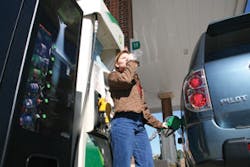Convenience stores are the most significant competition for vending, OCS and onsite foodservice operations. To learn more about where the convenience store channel is headed in these challenging times, I went to the National Association of Convenience Store (NACS) Show in Las Vegas.
It was evident that the c-stores are using vending as a tool to win more sales. Vending is being used to simplify the customer shopping experience. Most of the vending innovations we’re seeing are completely cashless.
The first exhibit I noticed was Redbox, the completely cashless DVD rental vending machine which has been hammering the traditional movie rental industry. Redbox has apparently decided to expand its presence to c-stores.
Next we came upon Vend Gogh LLC. They provide an at-the-pump vending solution to deliver cold drinks as part of the gas purchase transaction; there is no need to go inside the store to get a soft drink, sports drink or bottle of water.
The Vend Gogh machine does not accept coins or bills or cards. It only dispenses products based on receiving a confirming authorization from the c-store’s gas pump payment system. The card-reader-in-dispenser (CRIND) is what we all use to buy gas when we pay at the pump. Now that same CRIND will let you pay for, select and get a cold drink at the pump without leaving the gas island.
The Vend Gogh machine will feature advertising on all four sides. Future developments will include candy and snack sales at the pump. The first placements are planned for early 2010.
THE GREEN THEME TAKES CENTER STAGE
Going green is a big consumer issue, and c-stores aren’t ignoring it. They see it as a way to connect more effectively with the shoppers they serve and the communities where they operate.
TOMRA North America demonstrated its reverse vending machines for recycling beverage containers. In October 2009, New York State and Connecticut added bottled water to their deposit laws. Retail stores in both states expect deposit container flows will increase by as much as 30 percent.
For vending and onsite operations, as much as 50 percent of the foodservice trash volume can be beverage containers. What would you do if your client locations asked you to share in the added cost of their trash service?
FOCUS ON COFFEE AND FOODSERVICE
The c-stores have been part of the coffee revolution, and the show floor showcased Coca-Cola’s Coffeecol system. This is a Juan Valdez brand coffee prepared from bag-in-the-box liquid coffee extract.
Foodservice has become the number one in-store sales category for many convenience store operators (excluding beer and/or tobacco) — more in dollar sales than cold beverages, candy or snacks.
Foodservice has also become the singular point of differentiation for the best in class c-stores. Chains like Wawa, Sheetz and others have established proprietary foodservice programs making their stores destinations of choice in their market areas.
The gross profit margin for foodservice in c-stores is 47 percent, according to the NACS State of the Industry Report. That’s pretty close to what we see in vending. The difference versus vending is that in c-stores, candy (at 46.3 percent) and snacks (at 33.3 percent) have lower margins than foodservice. Is it any wonder that c-store operators are looking to drive growth with their foodservice programs?
Data was presented showing that the innovative companies are growing — even in this difficult economy. The value of super heavy users (SHUs) was demonstrated: 30 percent of c-store shoppers account for 74 percent of in-store dollar sales. The most significant SHUs, those who spend more than $10 per visit and who shop most frequently are 7 percent of the shoppers and account for 39.8 percent of sales. That group is contributing to c- store channel growth — even as industry sales are under pressure.
Research was presented from the NACS/Coca-Cola Retailing Research Council. Two c-store chains presented what they have done in response to the research.
Lighting on the lot was improved at one chain to make the whole area safer for night time gas and in-store shoppers. To allow for cleaner lines of sight in to the store, window signs were removed, displays were minimized around the entrance, and store aisle fixtures were lowered in height. Music was piped in to enhance the ambiance. The cost, per store, was $10,000 to make these improvements. Results will be tracked and specific measures have been set for evaluation.
C-stores have also upgraded their restrooms (modernized the ambiance and made a regular cleaning schedule a priority), added new foodservice offerings and enhanced their roller grill offerings.
For vending, OCS and onsite foodservice operators, when you plan what you will sell, is it based on simplifying the shopping process?
For more information, contact:
Coca-Cola Juan Valdez caféREALE, www.coffeecol-usa.com/service.htm
TOMRA North America, 203-447-8779, www. uno.tomra.com/?nid=36&lcid=1033
Vend Gogh LLC, 888-466-8886, www.vendgogh.com






